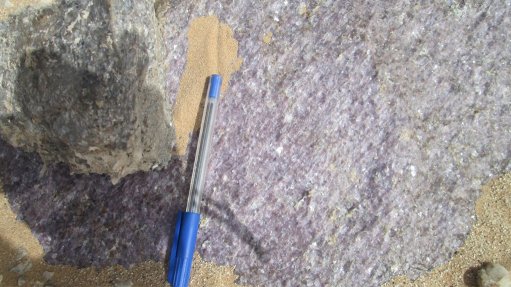
LITHIUM LIKING The best flotation testwork on spodumene pegmatite achieved an overall lithium recovery of 81.8% and a concentrate containing 6.5% lithium oxide
Diversified exploration and mining company Premier African Minerals reported “excellent results” from the initial metallurgical testwork study, which was completed by German materials testing and analysis company Dorfner Anzaplan on its wholly owned Zulu lithium and tantalum project, in Zimbabwe, last month.
Premier chairperson and CEO George Roach says that the company will undertake additional testwork to improve not only the recoveries of lithium and associated minerals, but also flow sheet design, as well as ascertain capital and operating costs for producing lithium from Zulu.
He notes that the best flotation testwork on spodumene pegmatite achieved an overall lithium recovery of 81.8% and a concentrate containing 6.5% lithium oxide and 0.09% iron oxide. Roach states that this is well within the typical range of spodumene concentrates for glass and ceramics, as well as for feedstock for conversion into lithium carbonate.
He remarks that the best flotation testwork on a mixed pegmatite sample achieved a spodumene concentrate containing 5.9% lithium oxide, which is acceptable for spodumene concentrates as feedstock for lithium carbonate production, as well as a commercial-grade petalite concentrate containing 3.9% lithium oxide with an “exceptionally low” iron oxide content of less than 0.01% at an overall recovery in the concentrates of an estimated 70%.
Roach points out that the tailings of spodumene and petalite flotation contain very low iron oxide concentrations of about 0.01%, offering the potential for producing high-quality, low-iron feldspar and quartz as by-products for glass and ceramics applications.
Further metallurgical testwork is planned, including tests on the recoveries of lithium-bearing minerals, the recovery of saleable tantalite concentrates and high-purity, low-iron oxide quartz and feldspar concentrates, as well as an optimised flow sheet design.
Dorfner also recommends a testwork programme for lithium extraction to produce lithium carbonate and hydroxide to prove that marketable lithium carbonate and hydroxide can be produced.
“The metallurgical testwork results and the recently announced maiden inferred mineral resource estimate at Zulu of 20.1-million tons grading 1.06% lithium oxide on only a part of the 3.5 km strike length of the Zulu project again confirm that the Zulu project has all the hallmarks of a world-class lithium project,” Roach concludes.